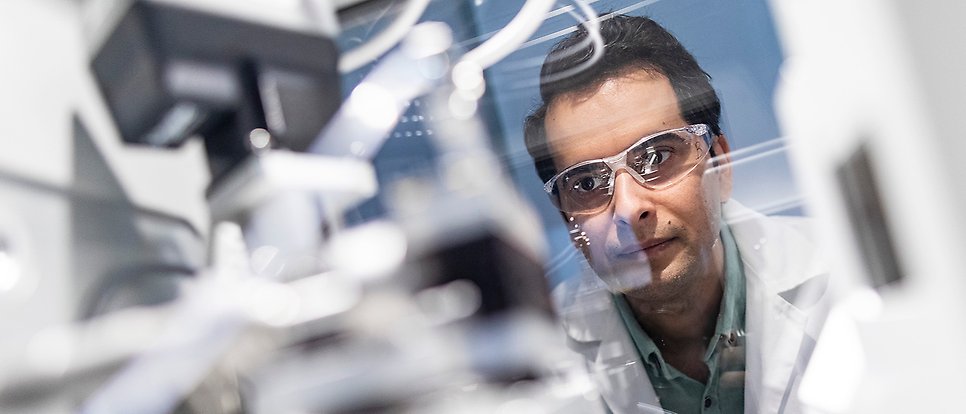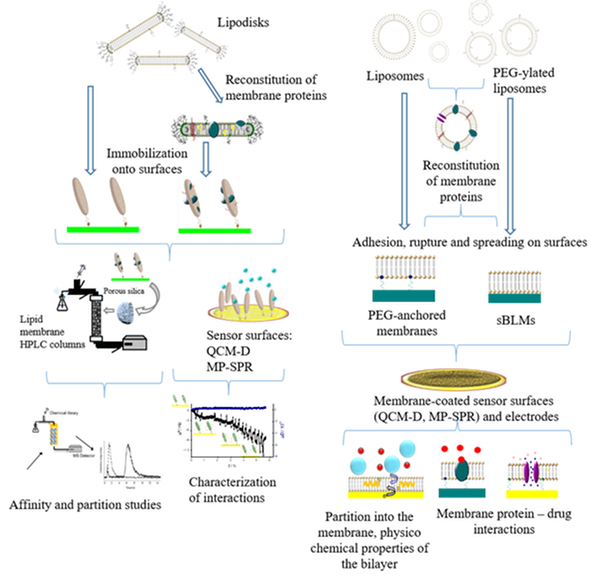Lipid membrane based nanoparticles

Research with a focus on Lipid membrane-based nanoparticles and supported structures as nanocarriers and biomimetic systems
Details
- Funder: Vinnova
Lipid membrane-based nanoparticles and supported structures as nanocarriers and biomimetic systems
Lipid membranes play a key role in nature: they build the barriers separating living cells from their environment. These membranes are self-assembled structures, meaning that they form spontaneously when the lipids are mixed with water. The same phenomenon can be easily reproduced in the laboratory, giving rise to structures that strongly resemble biological membranes.
Dispersed systems based on self-assembled lipid bilayer structures, such as liposomes and lipodisks, are widely studied due to their unique properties as, e.g., biomimetic structures and drug carriers.
Development of lipid-based nanoparticles as drug nanocarriers
We study the suitability of novel lipid-based nanoparticles as carriers for molecules of therapeutic interest, as, e.g., antimicrobial peptides. The interactions between the carriers and the drugs are characterized in order to understand the physicochemical parameters affecting the loading and release of the molecules of interest into and from the carriers. We also study and characterize any structural changes caused by the inclusion of amphiphilic or hydrophobic drugs into the lipid membrane structure.
Fundamental studies on lipid membrane behavior
We perform fundamental physicochemical studies on the behavior of lipid membranes and lipid-based nanoparticles. Of particular interest is the interaction between lipid-based nanoparticles with each other, with other nanoparticles, and with solid substrates. The results from this project have proven useful to improve lipid-based formulations and avoid unwanted interactions with either other particles or the containers. We have, e.g., developed methods to decrease the unwanted and non-specific interactions of liposomes with glass and quartz surfaces via surface and/or liposome modifications.
We also develop new experimental approaches to characterize the properties of lipid membranes, such as their permeability towards solutes and their mechanical properties. The new methods thus developed are helpful to characterize the effect of different components of the lipid membrane, to understand the effect of membrane-embedded molecules on the nanoparticle’s structure, to predict the suitability of novel nanoparticles as drug nanocarriers, etc.
Supported lipid bilayer structures as biomimetic systems
Lipid bilayers are found at the core of all cellular membranes and they are key elements in building the barriers enclosing different organelles and the cell itself. Therefore, all interactions of a cell with its surroundings, including the uptake of therapeutic drugs, are at some point mediated by a lipid bilayer.
Our research focuses on the design and use of immobilized lipid membrane structures in order to set the basis for the development of new lipid-modified surfaces suitable for fundamental studies on lipid-membrane behavior, as well as for electrochemical and nanogravimetric analyses to characterize membrane-analyte interactions. The lipid-based structures most commonly used in my research are lipodisks (are planar lipid bilayer structures whose rim is stabilized by lipids modified with polyethyleneglycol), liposomes (lipid membrane vesicles), and supported bilayer lipid membranes (sBLMs). These structures can even include integral membrane proteins in an environment mimicking the native cell membrane, thus allowing studies of protein/analyte interactions.
The figure below shows a schematic representation of the objectives, strategies, and methods used in my research.

Figure 1: Schematic representation of the objectives, strategies and methods used in my research. Perpendicularly oriented membranes (respect to the substrate, see left side of the figure) can be used for interaction, affinity and partition studies using chromatography and surface sensitive methods. Membranes supported parallel to the substrate (right side of the figure) can be used in conjunction with electrochemical and surface sensitive methods to determine water/membrane partition coefficient of ionic drugs, as well as for complementary studies on membrane protein function and interactions.
Víctor Agmo Hernández, Principal investigator
Department of Medicinal Chemistry
Victor.Agmo@ilk.uu.se
